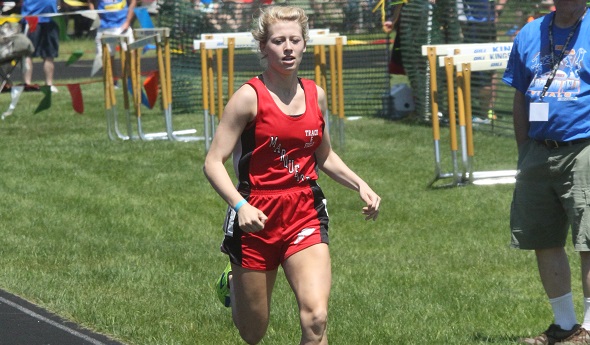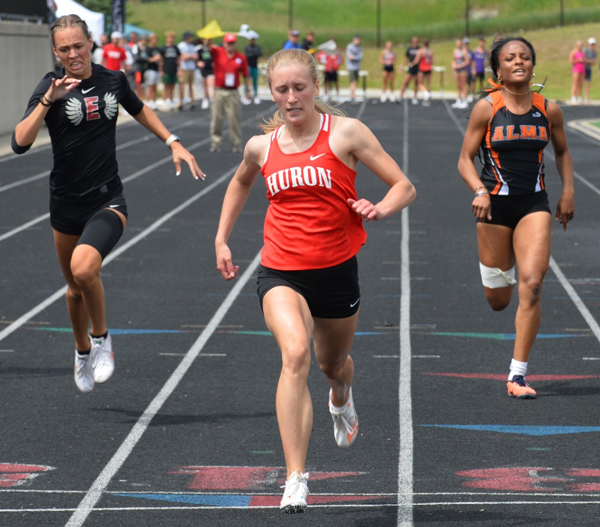
Marquette 4-Peat Full of Milestones
By
John Vrancic
Special for MHSAA.com
May 31, 2014
KINGSFORD — Marquette sophomore Lindsey Rudden on Saturday became the first female athlete to break the five-minute barrier in the Upper Peninsula Track and Field Finals, earning her second straight Division 1 title in 4 minutes, 55.28 seconds.
“At the beginning of the season, this was my goal,” she said. “I had a cheering section here and wanted to do something extraordinary. I can’t thank my parents, teammates and coaches enough. I just feel blessed to have this opportunity and be able to do it.”
She was followed by freshman teammate Amber Huebner at 5:15.25 and Menominee senior Kameron Burmeister (5:17.66) on a sunny and hot day at Flivver Field.
The Marquette girls were crowned champions for the fourth straight year with 145 points. They were followed by Escanaba with 86 and Negaunee with 71.
“The girls took care of business,” said Marquette coach John Peterson. “As coaches we were a little concerned because of the heat. But the girls were very disciplined and stayed under the bleachers until it was nearly time to do their events. Lindsey told me she wanted to break five minutes. We knew it was coming. We just didn’t know it would happen this soon. I told her to take it easy at first and if it felt right, go for it. It was a hot day, but a good day for our team.”
Rudden scratched from the 400 to allow for more recovery time, then retained her 800 title (2:23.54) and helped the winning 1,600 relay.
Huebner captured the 400 (1:00.44) and 3,200 (11:48.8), using a strong final lap to overtake Burmeister (11:54.32), and placed second in the 800 (2:24.12).
“It’s always hard to lead because you can hear the person behind you breathing,” said Huebner. “Plus, Kameron was hurting a little (with a sore hip). I feel bad for her. I just wanted to do my best in the 400. Hopefully, next year I can break a minute. Being my first time here, I was a little nervous. But the upperclassmen helped me through it. The whole team did a real good job. We all did what we had to do. We couldn’t have done it without Coach P.”
Marquette junior Hunter Viitala won the 300 hurdles in a school-record 46.27 seconds and helped the 1,600 relay. She also helped the Redettes place second in the 800 relay and took third in high jump at 4 feet, 10 inches.
“It was cool to see Hunter set the school record in the 300 hurdles,” said Peterson. “We certainly appreciate the efforts of our assistant coach Natalie Messano. She does a nice job with our sprinters and hurdlers.
“I think the U.P. Track FInals are the greatest athletic event in the Upper Peninsula. Getting the opportunity to see so many athletes compete on the same day is phenomenal.”
Escanaba senior Lynsey Collins anchored the winning sprint relays and was runner-up in the 300 hurdles (47.74) and fifth in the 100 (13.59).
Negaunee opened the day by winning the 3,200 relay, and junior Hailee Richards won discus (111-1).
Calumet junior Chelsea Jacques captured the 100 (12.73) and 200 (26.5) and anchored the second-place 400 relay, which finished just two steps behind Escanaba.
PHOTO: Marquette's Lindsey Rudden leads the field during one of her championship runs Saturday at Kingsford.. (Click to see more from RunMichigan.com.)

Multi-Sprint Champ Racing to Finish Huron Career Ahead of the Rest Again
By
Keith Dunlap
Special for MHSAA.com
May 25, 2023
NEW BOSTON – If there was one thing Elizabeth Anderson took pride in elementary school, it was simply showing that she could outrun everyone in sight.
 In fact, Anderson has an explanation for all the success she had in those playground races.
In fact, Anderson has an explanation for all the success she had in those playground races.
“Dominance when you are in elementary school,” Anderson quipped. “I don’t think I ever had a nickname. I just think everyone knew I was fast.”
Years later, pretty much everyone who follows track & field in the state of Michigan can attest to that.
A senior for New Boston Huron, Anderson has been faster than most other competitors in the state during her three-year high school career (with her freshman season in 2020 canceled due to COVID-19).
Last year, Anderson won titles at the Lower Peninsula Division 2 Finals in the 200-meter (25.07) and 400-meter (56.28) dashes, and was runner-up in the 100-meter dash (12.23).
Often, top sprinters focus on one or two of those three races. But Anderson is certainly a different breed of sprinter because she does all three.
In fact, she holds school records in all three of those events, and if all that weren’t enough, Anderson is a part of all three sprint relay teams.
“It is hard to give her events off,” said New Boston Huron head girls track coach Danielle Lobato.
Despite the different styles the 100, 200 and 400-meter dashes present, Anderson said there usually isn’t much adjusting when she goes from one of those races to another.
 The strategy is simply, “Let’s beat the other girls to the finish line.”
The strategy is simply, “Let’s beat the other girls to the finish line.”
“I don’t really go into each race changing up how I would run,” she said.
While enjoying and succeeding in all three races, Anderson said she actually does have a favorite among them.
“I would say the 400 is probably my favorite,” she said. “Even though it hurts, it’s satisfying to see how much you can get your time down in the 400 compared to any other race.”
Anderson said she started running track in sixth grade, but really got serious about it during the summer after her sophomore season, when she was invited to run for a local club.
Eventually, that led to her competing over the winter in indoor events.
She lived and breathed track so much that last fall, she decided to not run cross country so she could focus on a weightlifting regimen aimed at developing more leg strength.
“Once I started doing summer track, I realized I wanted to be doing this all the time,” she said.
Lobato said oftentimes in practice, Anderson is a de facto coach, given there is no better person she can think of for the younger runners on the team to learn from.
“I can’t always demonstrate these things I’m trying to teach,” she said. “You get to see it in real life (from Anderson), not in a YouTube video.”
After winning the 100, 200 and 400-meter dashes at her Regional meet last week, Anderson has her sights set on achieving the same trifecta of titles at next Saturday’s Finals in Grand Rapids.
Anderson has signed to run track at Michigan State, but has been plenty motivated to keep producing this spring in her final high school season.
“I’m really looking to defend my titles,” she said. “That is what is really motivating me to keep going. I want to keep in shape for the college season. I don’t want to lose any of the progress I have made. Ultimately, I just love running track.”
And since elementary school, Anderson has loved — and succeeded in — outrunning everyone else to the finish line.
“We knew we were getting something special,” Lobato said of when Anderson arrived in high school. “But you never expect this. All that she has accomplished is amazing.”
 Keith Dunlap has served in Detroit-area sports media for more than two decades, including as a sportswriter at the Oakland Press from 2001-16 primarily covering high school sports but also college and professional teams. His bylines also have appeared in USA Today, the Washington Post, the Detroit Free Press, the Houston Chronicle and the Boston Globe. He served as the administrator for the Oakland Activities Association’s website from 2017-2020. Contact him at [email protected] with story ideas for Oakland, Macomb and Wayne counties
Keith Dunlap has served in Detroit-area sports media for more than two decades, including as a sportswriter at the Oakland Press from 2001-16 primarily covering high school sports but also college and professional teams. His bylines also have appeared in USA Today, the Washington Post, the Detroit Free Press, the Houston Chronicle and the Boston Globe. He served as the administrator for the Oakland Activities Association’s website from 2017-2020. Contact him at [email protected] with story ideas for Oakland, Macomb and Wayne counties
PHOTOS (Top) New Boston Huron's Elizabeth Anderson clears the finish line during last season's LPD2 400 race. (Middle) Anderson, middle, outpaces the field to also win the 200. (Click for more from RunMichigan.com.)

